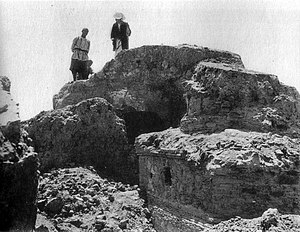 The Stupa at Tepe Maranjan The Stupa at Tepe Maranjan | |
    | |
| Coordinates | 34°31′04″N 69°12′30″E / 34.517801°N 69.208328°E / 34.517801; 69.208328 |
|---|---|
| Type | Monastery |
Tepe Maranjan ("Maranjan Hill"), previously known as Siyah Sang (Persian: سياه سنگ, "Blackstone"), is a small hill in southeastern Kabul, Afghanistan.
Buddhist monastery
Tepe Maranjan was the site of a Buddhist monastery that appears to have been founded in the 4th century, the 6–7th century of Buddhism in Afghanistan. It lies east of the tomb of Nadir Shah and south of the road from Kabul to Jalalabad and Peshawar.
The site was excavated by the French DAFA Jean Carl in 1933, again by Gérard Fussman in 1976, and again by Zemaralaï Tarzi of the Afghan Institute of Archaeology more recently. Many Buddhist sculptures were discovered on the site. They are made of clay and represent a style intermediate between the sculptures of Hadda and those of the Fondukistan monastery. Tepe Maranjan can be considered as generally representative of the art of Gandhara of the 5th or 6th century.
A large hoard of Sasanian Empire coins was also discovered at Tepe Maranjan: 367 Sassanian silver drachms from the reigns of kings Shapur II (r. 309–79) and Ardashir II (r. 379–83), which, owing to their uniformity, are thought to have been minted in the vicinity of Kabul. The hoard also contained 12 scyphate gold dinars of the Kidarites, which might have circulated at the same time as the Sassanian coins, or may have been added later.
Gallery
-
 Seated Buddha at Tepe Maranjan
Seated Buddha at Tepe Maranjan
-
 Kneeling Buddhist donors at Tepe Maranjan
Kneeling Buddhist donors at Tepe Maranjan
-
 Tepe Maranjan Bodhisattva head
Tepe Maranjan Bodhisattva head
-
 Tepe Maranjan seated Bodhisattva
Tepe Maranjan seated Bodhisattva
-
 Coin in the name of Kidara I, with legend "βαγο Κιδαρο οοζορκο κοþανοþαο" "Kidara, the great Kushanshah", of the type found in Tepe Maranjan (Type 6A-D), dated to before 388 CE.
Coin in the name of Kidara I, with legend "βαγο Κιδαρο οοζορκο κοþανοþαο" "Kidara, the great Kushanshah", of the type found in Tepe Maranjan (Type 6A-D), dated to before 388 CE.
See also
References
- ^ Dani, Ahmad Hasan; Harmatta, János (1999). History of Civilizations of Central Asia. Motilal Banarsidass Publ. p. 360. ISBN 978-81-208-1408-0.
- Kuwayama, Shoshin (1991). "The Horizon of Begram III and Beyond A Chronological Interpretation of the Evidence for Monuments in the Kāpiśī-Kabul-Ghazni Region". East and West. 41 (1/4): 100 (22). ISSN 0012-8376. JSTOR 29756971.
- Francine, Tissot (31 December 2006). Catalogue of the National Museum of Afghanistan, 1931-1985. UNESCO Publishing. p. 343. ISBN 978-92-3-104030-6.
- ^ ALRAM, MICHAEL (2014). "From the Sasanians to the Huns New Numismatic Evidence from the Hindu Kush". The Numismatic Chronicle. 174: 261–291. ISSN 0078-2696. JSTOR 44710198.
- Bakker, Hans T. (2017). The Huns in Central and South Asia. How Two Centuries of War against Nomadic Invaders from the Steps are Concluded by a Game of Chess between the Kings of India and Iran.
| History of Central Asia | |||||||||||||||||||||
|---|---|---|---|---|---|---|---|---|---|---|---|---|---|---|---|---|---|---|---|---|---|
| Polities |
| ||||||||||||||||||||
| Culture | |||||||||||||||||||||
| Archaeology |
| ||||||||||||||||||||
| Artifacts |
| ||||||||||||||||||||